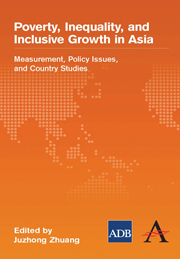Book contents
- Frontmatter
- Contents
- Foreword
- Preface and Acknowledgments
- Contributors
- Abbreviations, Acronyms, and Symbols
- Tables, Figures, and Boxes
- 1 Poverty, Inequality, and Inclusive Growth in Asia
- Part A Measuring Inequality and Poverty
- Part B Selected Policy Issues for Inclusive Growth
- 5 Inclusive Growth through Full Employment: The Role of Investment and Industrial Policy
- 6 Why is Access to Basic Services Not Inclusive?
- 7 Social Protection in Asia
- 8 Governance and Institutional Quality and the Links with Growth and Inequality: How Asia Fares
- Part C Country Studies
- Index
5 - Inclusive Growth through Full Employment: The Role of Investment and Industrial Policy
from Part B - Selected Policy Issues for Inclusive Growth
Published online by Cambridge University Press: 05 March 2012
- Frontmatter
- Contents
- Foreword
- Preface and Acknowledgments
- Contributors
- Abbreviations, Acronyms, and Symbols
- Tables, Figures, and Boxes
- 1 Poverty, Inequality, and Inclusive Growth in Asia
- Part A Measuring Inequality and Poverty
- Part B Selected Policy Issues for Inclusive Growth
- 5 Inclusive Growth through Full Employment: The Role of Investment and Industrial Policy
- 6 Why is Access to Basic Services Not Inclusive?
- 7 Social Protection in Asia
- 8 Governance and Institutional Quality and the Links with Growth and Inequality: How Asia Fares
- Part C Country Studies
- Index
Summary
Introduction: What is inclusive growth?
While developing Asia has done remarkably well during the last 4 decades, achieved high growth, and reduced poverty significantly, Felipe and Hasan (2006) estimate that there are still about 500 million people unemployed and/or underemployed in the region. Perhaps for this reason during the last few years, terms such as “harmonious society” in the People's Republic of China (PRC), “sufficiency economy” in Thailand, and the like in other countries, have made their way into policy making discussions across Asia. The Indian government, for example, boasts of having fostered “inclusive growth”. By this it means that the budget has increased allocations to school meals or rural road-building (The Economist 2008). The message in all cases is similar: development is more than growth. The high-growth policies implemented across the region since the 1960s were successful and led to increases in per capita income and dramatic reductions in poverty; helping to close the gap with the developed world. But there is a feeling today that these policies have become obsolete and citizens in Asia demand more than growth. Issues such as inequality, the environment, health, or climate change are becoming increasingly important in the agendas of policy makers. Institutions such as the World Bank or the Asian Development Bank also acknowledge the issue and argue that growth and globalization have to be inclusive.
- Type
- Chapter
- Information
- Poverty, Inequality, and Inclusive Growth in AsiaMeasurement, Policy Issues, and Country Studies, pp. 161 - 198Publisher: Anthem PressPrint publication year: 2010



